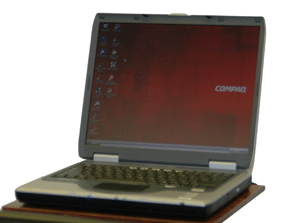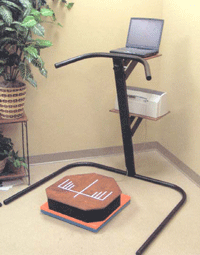|
 |
SCOTTTRAK MOBILE VNG EQUIPMENT |
 |
CALL FOR PRICING AND SUPPORT
|
 |
|
MOBILE CONFIGURATION
Laptop Computer with
Windows XP with 15" LCD Screen
Infrared Goggle Assembly with Active
Head Rotation (AHR)
Interface Control-AHR
AHR Receiver
Foot Switch Assembly
DC Power Supply
Video Capture Cables USB
Accessories and Cables
One Interpretation Flash Drive Assembly
|
 |
 |
SCOTTTRAK REHABILITATION EQUIPMENT |
 |
CALL FOR PRICING AND SUPPORT
|
 |
SCOTTTRAK CONFIGURATION
Balance plate (20 x 20 x 2 ½ inches; 7 pounds)
Perturbed foam for assessment
Balance plate to computer USB cable
Training structure (80 pounds)
Perturbed surface for training
Laptop computer (with software installed)
Computer case
Printer and cable
Software on CD
User manual
Shipped in three boxes |
 |
VIDEO NYSTAGMOGRAPHY DIAGNOSTIC
TESTING |
 |
Video Electronystagmography (VNG) is a non-invasive,
non-pharmaceutical technology that provides an objective diagnosis of
the cause of dizziness, unsteadiness, vertigo and other balance
disorders using normative data. Because it provides an objective
measurement of the patient’s progress, it can also be used to determine
the effectiveness of treatments for balance disorders.
VNG analyzes the cause of a patient’s balance disorders by testing
oculomotor response to visual, positional and caloric stimulus. The
patient’s oculomotor response is measured against objective criteria,
and the practitioner receives an objectively measured balance assessment
that differentiates between peripheral and central vestibular pathology.
Results appear on the screen and a printout of normative data and the
patient’s results are generated for the patient’s medical record.
For the VNG test, goggles are placed on the patient while an infrared
camera connected to a computer measures nystagmus (eye movement) during
different types of stimulation (visual, positional and caloric). A
pattern of eye movement is recorded, producing data from which the
practitioner is able to determine whether the pathology is of central or
vestibular origin, whether it is ocular-motor, or whether the patient
has benign paroxysmal positional vertigo (BPPV).
 |
SCOTTTRAK REHABILITATION TESTING AND TREATMENT |
 |
SCOTTTRAK Rehabilitation Testing and Treatment System (SRT) provides a physical
performance test (PPT) which is non-invasive, non-pharmaceutical
technology that provides an objective assessment of a patient’s balance
disorder by utilizing force plate technology and normative data. Because
it provides an objective measurement of the patient’s progress, it can
also be used to determine the effectiveness of treatments for balance
disorders.
SRT analyzes the patient’s balance disorder by testing the three
systems of balance and equilibrium (Vision, Vestibular and
Somatosensory). The patient’s responses are measured and compared to age
matched normative data and the practitioner receives an objectively
measured balance assessment differentiating between visual, vestibular
and somatosensory pathology. Results appear on the screen and a printout
of normative data and the patient’s results (to three standard
deviations) are generated for the patient’s medical records.
For the PPT, the patient stands on a computerized force plate which then
records the patient’s standing balance when all three balance systems
are being utilized, when the visual system only is removed, when the
somatosensory system only is removed and then when both the visual and
somatosensory systems are removed. Utilizing the patient’s height and
age, limits of stability and age matched norms are then measured,
recorded and compared, producing graphs and data from which the
practitioner can determine the patient’s weakest balance systems and the
patient’s “risk for falling.” This assists the practitioner in
determining an appropriate treatment plan for rehabilitation.
SRT is then utilized as one of the tools for rehabilitating individual
patients. The patient can be run through a battery of individualized
treatment programs designed specifically for each individual’s deficits
which were found during the VNG test and PPT . These programs involve
following patterns which challenge the patient’s balance and limits of
stability while standing on the computerized force plate on stable and
non-stable surfaces. Each patient’s treatment session is recorded and
the practitioner can then monitor the progress of the patient from
session to session.
|
